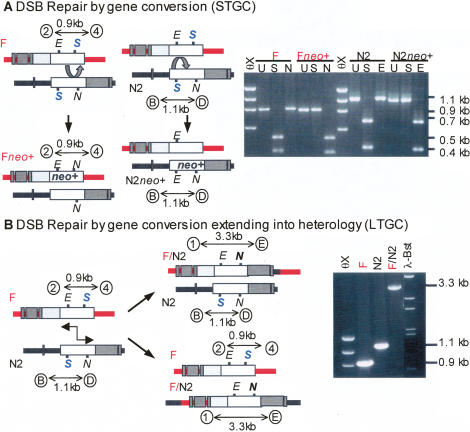Figure 3.
Classification of DSB-induced gene conversion repair events. (A) DSB repair of parental alleles by gene conversion (STGC). Following DSB at either I-SceI site (S), strand invasion and repair synthesis (denoted by curved arrow) limited to homologous neo sequence results in gene conversion (STGC) and restoration of an NcoI site (N) on the Fneo+ allele or EagI site (E) on the N2neo+ allele. PCR amplification of neo genes in recombinant clones from parental or repaired alleles. The F allele gives a 0.9-kb product using primers 2 and 4, and the N2 allele gives a 1.1-kb product using primers B and D. There is no change in this uncut (U) PCR product size between parental and converted alleles. Conversion leads to loss of the I-SceI site (S) and absence of digestion, and gain of NcoI (N) or EagI (E) site and gain of digestion. (B) DSB repair of parental alleles by gene conversion extending into heterology (LTGC). Following DSB at either I-SceI site (S) on F or N2, strand invasion and repair synthesis (denoted by two-headed arrow) extended beyond homology into downstream heterologous sequence resulting in a neo+ hybrid F/N2 allele. This event is detectable by PCR using primers 1 and E from sequences flanking the DSB sites on opposite alleles (hygR and HPRT) to yield a 3.3-kb product. There is no change in the other allele in these events; the F allele gives a 0.9-kb product using primers 2 and 4, and the N2 allele gives a 1.1-kb product using primers B and D.

